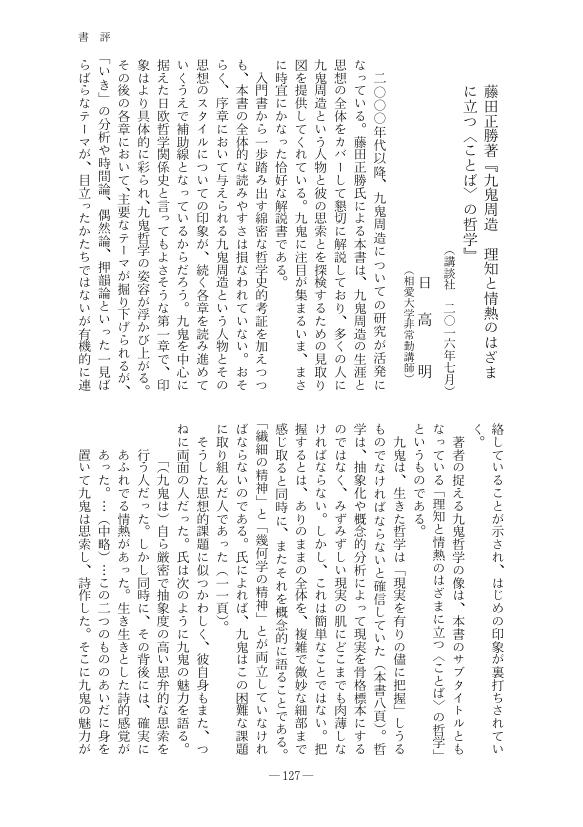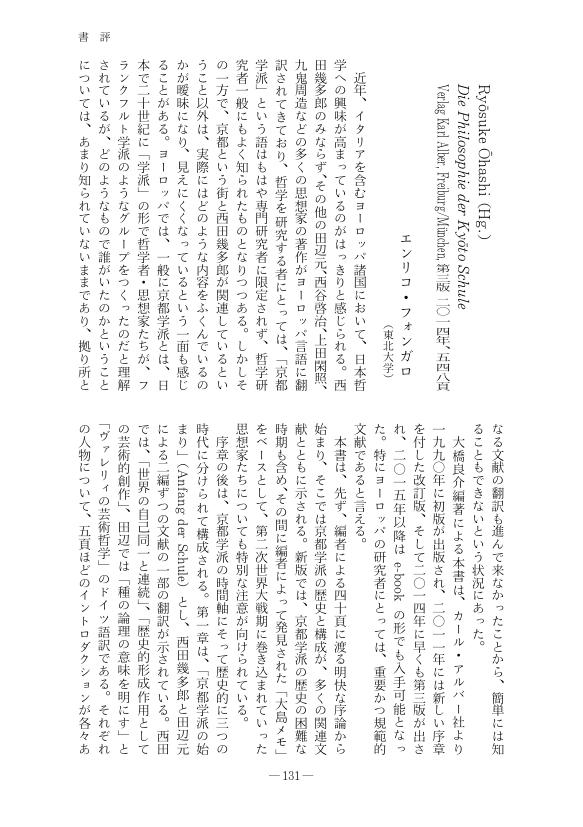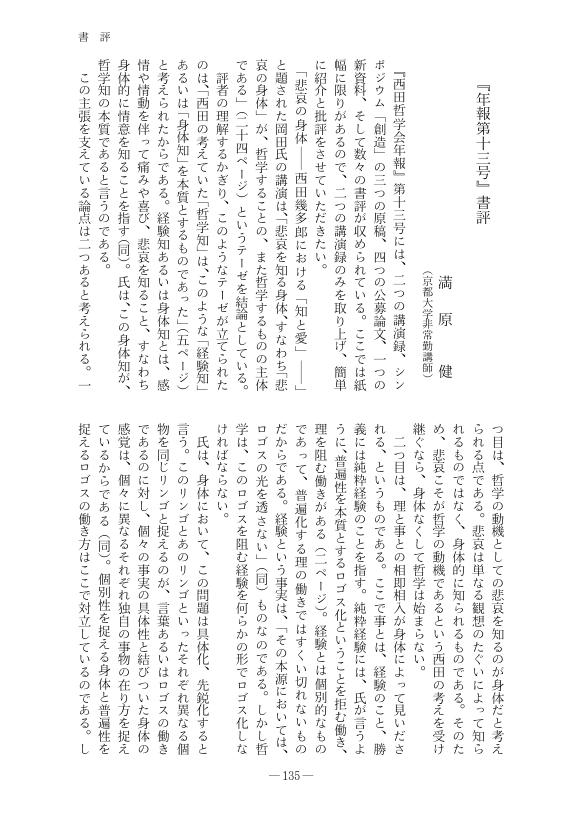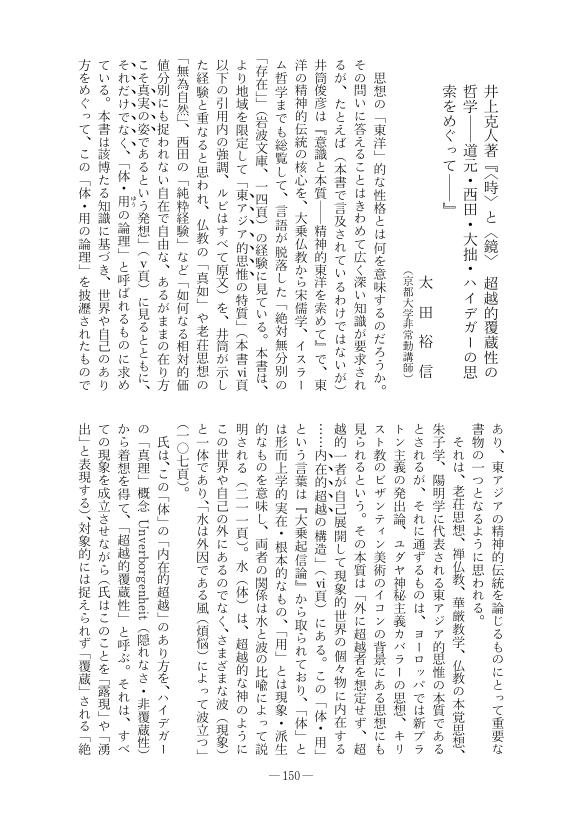1 0 0 0 OA 書評 板橋勇仁著『底なき意志の系譜 ― ショーペンハウアーと意志の否定の思想』
- 著者
- 田中 裕
- 出版者
- 西田哲学会
- 雑誌
- 西田哲学会年報 (ISSN:21881995)
- 巻号頁・発行日
- vol.14, pp.123-126, 2017 (Released:2020-03-21)
1 0 0 0 OA 書評 藤田正勝著『九鬼周造 理知と情熱のはざまに立つ〈ことば〉の哲学』
- 著者
- 日高 明
- 出版者
- 西田哲学会
- 雑誌
- 西田哲学会年報 (ISSN:21881995)
- 巻号頁・発行日
- vol.14, pp.127-130, 2017 (Released:2020-03-21)
- 著者
- フォンガロ エンリコ
- 出版者
- 西田哲学会
- 雑誌
- 西田哲学会年報 (ISSN:21881995)
- 巻号頁・発行日
- vol.14, pp.131-134, 2017 (Released:2020-03-21)
1 0 0 0 OA 『年報第十三号』書評
- 著者
- 満原 健
- 出版者
- 西田哲学会
- 雑誌
- 西田哲学会年報 (ISSN:21881995)
- 巻号頁・発行日
- vol.14, pp.135-138, 2017 (Released:2020-03-21)
- 著者
- トランブレー ジャサント
- 出版者
- 西田哲学会
- 雑誌
- 西田哲学会年報 (ISSN:21881995)
- 巻号頁・発行日
- vol.14, pp.171-145, 2017 (Released:2020-03-21)
- 著者
- 太田 裕信
- 出版者
- 西田哲学会
- 雑誌
- 西田哲学会年報 (ISSN:21881995)
- 巻号頁・発行日
- vol.13, pp.150-153, 2016 (Released:2020-03-21)
1 0 0 0 OA 書評 檜垣立哉著『日本哲学原論序説 ― 拡散する京都学派』
- 著者
- 熊谷 征一郎
- 出版者
- 西田哲学会
- 雑誌
- 西田哲学会年報 (ISSN:21881995)
- 巻号頁・発行日
- vol.13, pp.154-157, 2016 (Released:2020-03-21)
1 0 0 0 OA 書評 小野寺功著『随想 西田哲学から聖霊神学へ』
- 著者
- 田中 裕
- 出版者
- 西田哲学会
- 雑誌
- 西田哲学会年報 (ISSN:21881995)
- 巻号頁・発行日
- vol.13, pp.158-162, 2016 (Released:2020-03-21)
1 0 0 0 OA 『年報第十二号』書評
- 著者
- 井上 克人
- 出版者
- 西田哲学会
- 雑誌
- 西田哲学会年報 (ISSN:21881995)
- 巻号頁・発行日
- vol.13, pp.163-166, 2016 (Released:2020-03-21)
1 0 0 0 OA 大地の思想のポテンシャル 鈴木大拙没後五十年に
- 著者
- 大橋 良介
- 出版者
- 西田哲学会
- 雑誌
- 西田哲学会年報 (ISSN:21881995)
- 巻号頁・発行日
- vol.14, pp.1-16, 2017 (Released:2020-03-21)
Zwar redet man seit alters her oft von der „großen Erde‟, aber in Wahrheit ist unsere Erde nur ein der zahllosen Himmelskörper in der Galaxis, die wiederum nur eine der ebenfalls zahllosen, mindestens mehrere Billionen Insel-Universen ist. Diese kleine Erde wird als Folge der Entwicklung der Verkehrs- und Kommunikationsmittel durch die moderne Technik immer kleiner. Der Mensch als das „Auf-der-Welt-Sein‟ ist das Wesen, das in sich sowohl die Größe wie auch die Kleinheit der Erde in sich spiegelt. Es gibt viele literarisch-philosophischen Zeuge dieser Anschauung. Um nur wenige Beispiele dafür anzugeben: „The Good Earth“ von Paul Back, „Die Brüder Karamasow‟ sowie „Schuld und Sühne“ von Dostojewski. Eine phänomenologische Betrachtung der Seinsweise der Erde ist in Husserls „Umsturz der kopernikanischen Lehre‟ zu finden, dessen Untertitel lautet: „Die Ur-Arche Erde bewegt sich nicht. Grundlegende Untersuchungen zum phänomenologischen Ursprung der Körperlichkeit der Räumlichkeit der Natur im ersten naturwissenschaftlichen Sinne‟. Heidegger legt eine andere, bis jetzt noch nicht erschöpfte Einsicht vor, indem er das „Geviert‟ von Himmel und Erde, Göttlichen und Sterblichen, denkt. Die heute dringende philosophische Frage, was die Erde für uns sei, kann mit Daisetsu ein Stück weiter entwickelt und vertieft werden. Daisetsu äußerte gegen Ende und nach dem Ende des Zweiten Weltkriegs einige Gedanke über die Bedeutung der Erde, die er später religionsphilosophisch vertiefte, indem er die genuine große Erde in der Grundgesinnung der „Compassion‟ im buddhistischen Sinne findet.
1 0 0 0 OA 西田哲学から聖霊神学へ トポロギー神学の成立をめぐって
- 著者
- 小野寺 功
- 出版者
- 西田哲学会
- 雑誌
- 西田哲学会年報 (ISSN:21881995)
- 巻号頁・発行日
- vol.14, pp.17-33, 2017 (Released:2020-03-21)
The author’s main concern in pursuing problems in philosophy has so far been with a possibility of establishment of a Christian theology, uniquely Japanese, with full comprehesion of Japanese spirituality, partially revealed by the logical steps taken by Nishida Kitaro in his philosophical studies. The result has been the author’s conclusion that there exists the royal road from Nishida’s philosophy to the theology of Holy Spirit, and that a passageway to the new philosophy should lie in systematic formation of the topological theology of Holy Trinity. In addition, the Christian faith, logically backed up by this theology of Holy Spirit, should not only bring itself into close contact with the philosophy of Japanese spirituality advanced by Suzuki Daisetsu but help to start a kind of religious revolution: something globally and universally awaited in this new century. Only in this direction is Nishida’s philosophy expected to be genuinely deepened and developed by his disciples. These are some of the conclusions that the author has reached at the end of his nearly livelong inquiry into these important philosophical and religious problems.
1 0 0 0 OA 閉じた個という不合理 フッサールと西田における他性の謎
- 著者
- 田口 茂
- 出版者
- 西田哲学会
- 雑誌
- 西田哲学会年報 (ISSN:21881995)
- 巻号頁・発行日
- vol.14, pp.34-50, 2017 (Released:2020-03-21)
We often think of consciousness as if it were a capsule surrounded by a boundary. In this paper, I will show in a phenomenological way that such an image of consciousness does not match the reality given to us. In fact, we cannot find any borderline of our own consciousness. This peculiarity of consciousness makes it difficult to understand how we can experience the otherness of the other. How can there be any otherness if there are no boundaries between consciousnesses? I shall make clear how Husserl and Nishida struggled with this fundamental problem. First, I interpret the “unbounded”character of consciousness as“non-contexutuality”.On the basis of this discussion, I present the basic question concerning the other experienced in consciousness. Second, I examine how Husserl addressed this question. The early Husserl tried to deal with this problem on the basis of his idea of“pure consciousness”which was construed as something “indefinite”.The collapse of this idea motivated Husserl to develop his later concept of“primal I”(Ur-Ich). Third, I discuss how Nishida dealt with the same question. After he tackled this problem in his early theory of“pure experience”,he would overcome this attempt in his later article“I and Thou”,which seems to stress the non-contextual encounter with otherness.
1 0 0 0 OA 超越論性の変容 西田とハイデガーにおける媒介と像
- 著者
- 村井 則夫
- 出版者
- 西田哲学会
- 雑誌
- 西田哲学会年報 (ISSN:21881995)
- 巻号頁・発行日
- vol.14, pp.51-71, 2017 (Released:2020-03-21)
Provided that philosophy is fundamental knowledge of the relation between world and spirit, it must be a radical reflection that includes not only the object of inquiry, but also the knowledge itself and its origin, which is transcendental thinking. Both Heidegger and Nishida, facing critical change in the traditional European sciences in general, were engaged in the rethinking and revival of the possibilities for the philosophical foundation of knowledge, the former based on the existential activities of life, and the latter on the ‘pure experience’ as base of all realities. In contemporary philosophy, these two insights are realized to have affinity with each other in the aspect of phenomenology. Hence, for the purpose of comparing the two creative philosophers, it is indispensable to take the problem of phenomenology into consideration, especially its thier deep investigation of the ‘medium’, through which phenomena show themselves. What is called ‘Dasein’ by Heidegger, ‘pure experience’ by Nishida, is nothing but the central sphere that conceives the whole reality and pure knowledge about it. The proximity of their modes of thinking, furthermore, extends to the dimension of fundamental and transcendental reflection on the occurrence of the unity of reality and spirit. Indicating such a thinking process, which would finally lead to the formation of transcendental speculation as ‘image’, is the aim of this article.
1 0 0 0 OA 創造に向かう 自己と世界のありかたに注目して
- 著者
- 水野 友晴
- 出版者
- 西田哲学会
- 雑誌
- 西田哲学会年報 (ISSN:21881995)
- 巻号頁・発行日
- vol.13, pp.42-55, 2016 (Released:2020-03-21)
1 0 0 0 OA 創造について 瞬間とポイエシス
- 著者
- 小林 信之
- 出版者
- 西田哲学会
- 雑誌
- 西田哲学会年報 (ISSN:21881995)
- 巻号頁・発行日
- vol.13, pp.56-71, 2016 (Released:2020-03-21)
1 0 0 0 OA 隠れ身(かむい)とアニミズム 創造の行方
- 著者
- 寺尾 寿芳
- 出版者
- 西田哲学会
- 雑誌
- 西田哲学会年報 (ISSN:21881995)
- 巻号頁・発行日
- vol.13, pp.72-85, 2016 (Released:2020-03-21)
The theory of Creation in Christianity has recently displaced its formerly established key concept of“Creation from Nothing”in the ontological form to the periphery and found its most central aspect in the experimental narrative of us who live in this world. The Creation in Holy Spirit indicates the intention of Creation in the future. In modern Japanese Catholicism, Onodera Isao has contributed much to its research and Oshida Shigeto has discerned it in the depth of the daily life world. Oshida’s spiritual journey was indispensable with the indigenous nature of the earth. He found the most primal word(koto-kotoba in Japanese)coming from the hole (ana in Japanese)as radical nothingness and showed himself as a shaman who was possessed with such words. This vision to the depth can be shared with the radical anthropologist Iwata Keiji who critically deconstructed the academically defined concept of“animism”and reconstructed it positively as a pre-interpreted encounter with the invisible“something great.”This intention can be linked with Miyamoto Hisao who sympathizes with the mourning thought of Ishimure Michiko as a spiritual companion with the deeply damaged casualties and patients in Minamata disease. Jürgen Moltmann also collaborates effectively in this stream with his unique idea of the non-created Sabbath. Silent Pentecostal will be expansively seen as an extension of such thoughts.
1 0 0 0 OA 「種の論理」と「間柄の倫理」の潜在的対立 田辺元・和辻哲郎における共通の課題
- 著者
- 服部 圭祐
- 出版者
- 西田哲学会
- 雑誌
- 西田哲学会年報 (ISSN:21881995)
- 巻号頁・発行日
- vol.13, pp.86-100, 2016 (Released:2020-03-21)
This paper contrasts Tanabe Hajime’s‘Logic of Shu’and Watsuji Tetsuro’s‘Ethics of Aidagara’in order to understand their common theoretical underpinning. Whilst they are considered as typical philosophers of the Kyoto school, how their respective thinking can be connected in a philosophical discussion remains to be made explicit. The task of connecting Tanabe’s‘Logic’and Watsuji’s‘Ethics’is a task I shall attempt in this paper. I shall begin with a discussion of Tanabe’s November 1934 paper“The Logic of social being”, in which he firstly defines his theoretical basis ‘Logic of Shu’. In his‘Logic’, he criticized not just Nishida Kitaro but also Watsuji Tetsuro and the latter’s“The Ethics as the theory of human being” published in March of the same year. The first section of this paper clarifies the structure of‘Logic of Shu’and how its criticism relates to Watsuji thinking. Next I shall offer a discussion of Watsuji’s magnum opus“Ethics” published in April 1937. He didn’t offer counterarguments to Tanabe directly, but formulated an‘Ethics of Aidagara’as a‘pre-logical’principle and idea that appears to be incompatible with Tanabe’s‘Logic’. The second section demonstrates that Watsuji countered Tanabe’s‘Logic’with the views expressed in his“Ethics”. Finally I shall view Tanabe’s‘Logic’and Watsuji’s‘Ethics’as two theories that arose from a common issue shared by both philosophers. Their different views as to how the society could be and should be, seems to be in conflict. If we re-evaluate their discussion on this issue, we shall realize that they should be considered as theories which complement each other.
1 0 0 0 OA 新資料「『価値生活の体験』序」、解題
- 著者
- 西田 幾多郎 秋富 克哉
- 出版者
- 西田哲学会
- 雑誌
- 西田哲学会年報 (ISSN:21881995)
- 巻号頁・発行日
- vol.13, pp.139-140, 2016 (Released:2020-03-21)
- 著者
- 石田 正人
- 出版者
- 西田哲学会
- 雑誌
- 西田哲学会年報 (ISSN:21881995)
- 巻号頁・発行日
- vol.13, pp.141-145, 2016 (Released:2020-03-21)
1 0 0 0 OA 書評 朝倉友海著『「東アジアに哲学はない」のか ― 京都学派と新儒家』
- 著者
- 林 永強
- 出版者
- 西田哲学会
- 雑誌
- 西田哲学会年報 (ISSN:21881995)
- 巻号頁・発行日
- vol.13, pp.146-149, 2016 (Released:2020-03-21)













